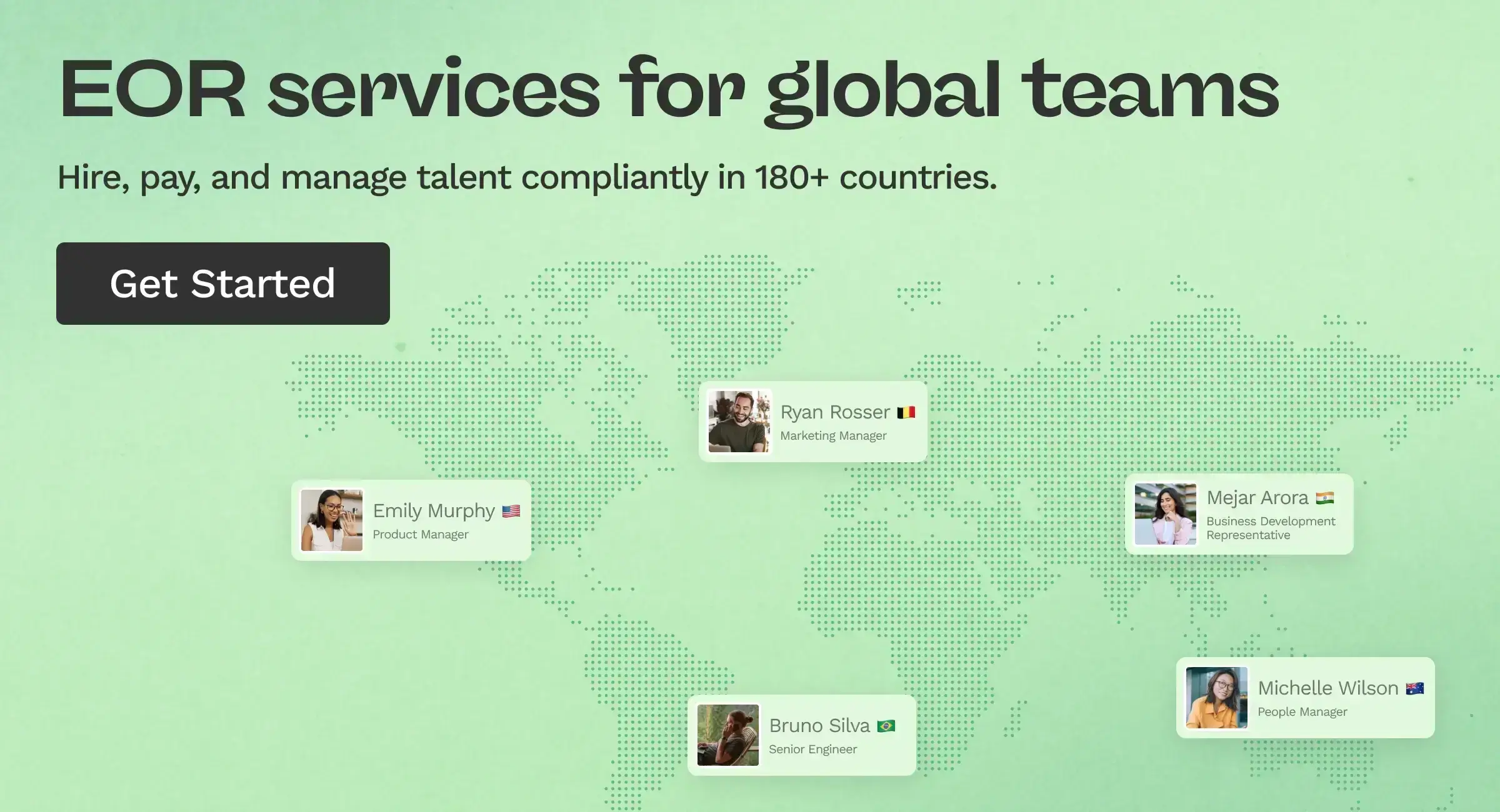Unemployment insurance (UI) acts as a safety net for workers who lose their jobs. It’s a legal and financial responsibility that varies by country. That’s why it’s common for employers managing global teams and navigating compliance across borders to wonder, “Who pays for unemployment?”
In this article, you’ll learn about UI, how it works, and who pays for unemployment benefits. We’ll also explore strategies you can use to manage unemployment costs while staying compliant.
What is unemployment insurance, and how does it work?
UI replaces a portion of lost wages when a worker loses their job through no fault of their own—such as through layoffs, seasonal shutdowns, or company restructuring. It softens the financial blow while employees search for their next role.
But how does unemployment insurance work? For employers, UI shows up as mandatory payroll taxes. In the U.S., those taxes fall under the Federal Unemployment Tax Act (FUTA) and parallel state programs, often called the State Unemployment Tax Act (SUTA). Each state sets its own wage base and tax rate, then manages claims and pays benefits. If a state fund runs low, it can borrow from the federal government using FUTA reserves.
Not every country runs unemployment insurance the same way. For example, in Canada, the federal government administers Employment Insurance (EI) through Service Canada—the agency that manages claims and payments. It oversees everything from processing claims to determining eligibility.
Who pays for unemployment insurance?
Employers fund UI through payroll taxes. For most U.S. employers, that means paying both federal and state taxes. Employees usually don’t chip in, although a few states—like Alaska, New Jersey, and Pennsylvania—do take a small percentage from employees’ paychecks.
At the federal level, employers pay FUTA tax on the first $7,000 of each employee’s wages. The base rate is 6%, but if you stay current on state taxes, you’ll usually qualify for a tax credit that reduces it to 0.6%. State unemployment tax varies widely. Some businesses with few claims pay under 1%, while frequent unemployment claims may see rates above 5%.
So, who pays unemployment—the state or the employer? In the U.S., the state handles the payments, but they draw from the taxes employers (and, in some cases, employees) have already contributed.
On average, unemployment covers about half of the employee’s previous wage. As of Q2 2025, the average weekly benefit varies from about $222 in Mississippi to more than $730 in Washington.
For employers with a global workforce, knowing whether you’re covering the full tax bill or splitting it with employees or the government depends on the country where your team members work. In Canada, both employers and employees pay into EI through payroll deductions. Germany takes a similar approach, with the government balancing the system during economic downturns.
Benefits of unemployment insurance for employers
UI supports workers, but it also has advantages for employers:
- Reduces layoff costs: When business conditions force you to cut staff, insurance steps in to provide income support. That means former employees aren’t relying solely on a severance package or other company-paid benefits.
- Supports workforce stability: Employees know that UI is there if the unexpected happens. That assurance can reduce anxiety and build trust, leading to better morale and stronger retention.
- Supports recovery after downturns: When employees receive unemployment benefits, they spend that money on essentials like food, shelter, and utilities. That can prevent demand from collapsing during a recession and help businesses recover faster once hiring and growth pick back up.
- Demonstrates compliance and good governance: Paying unemployment taxes and managing claims on time show you take regulations seriously. That builds credibility with regulators, investors, and employees, while lowering the risk of penalties.
What happens when an employee files an unemployment claim?
Here’s a look at what happens in the U.S. when a former employee files for unemployment.
1. The state notifies you
After a former employee files a claim, the state unemployment agency sends a notice requesting details. This includes the worker’s dates of employment, status (full-time, part-time, or seasonal), and the reason for separation. You need to respond by the deadline, or you risk penalties and a higher state unemployment tax rate.
2. You verify or contest the claim
If the separation was outside the worker’s control, you confirm the claim. If the employee quit or was fired, you can contest it and provide documentation. Examples include a resignation letter and performance reviews.
3. The agency decides
The state reviews the claim and issues a decision—often called a Notice of Determination. Employers can appeal the decision, and the agency may schedule a hearing. But the burden of proof sits with the employer when you argue misconduct. So you’ll need to present compelling evidence at the hearing.
4. You monitor charges and audit
When a former employee collects unemployment benefits, the state assigns the cost to your account. The state charges approved claims to your account, which impacts your experience rating—a score used to calculate your future state unemployment tax rate.
Regularly auditing any charges uncovers errors like overpayments. If you find discrepancies, request corrections or credits, which can lower your unemployment tax liability.
How can this affect your costs?
The state pays benefits using unemployment taxes it has already collected, so a single approved claim doesn’t create an immediate bill. Over time, however, more claims against your account can raise your state unemployment tax rate. This increases your payroll tax burden.
How to lower unemployment costs as an employer
While you can’t avoid unemployment taxes altogether, you can take steps to keep costs under control. Here are a few strategies:
- Strengthen your hiring process: Screen candidates carefully during interviews to reduce turnover and lower the risk of unemployment claims. Hiring the right employees means they’re less likely to leave early or struggle with performance issues that might lead to job loss.
- Invest in training and retention: Continuous development programs and retention strategies boost productivity and show employees you’re invested in their success. Team members who feel supported tend to stay longer, which lowers turnover and reduces the number of claims to your account.
- Review unemployment tax options: Some states let businesses adjust their tax rate by prepaying or restructuring contributions. Even if your state doesn’t, monitoring your account for errors or overcharges can prevent unnecessary increases.
- Use staffing flexibility wisely: Before bringing on new staff, consider whether seasonal workers or contractors can cover short-term needs. Smarter staffing choices can reduce layoffs later, keeping your unemployment tax rate steady.
Manage your team compliantly with Oyster
Navigating complex employment processes, including unemployment costs, can be challenging for global employers. Oyster makes it easy by bringing hiring, payroll, and benefits management onto one platform. With Oyster, you gain access to local expertise in over 180 countries, helping you comply with labor laws and give your distributed team a seamless experience.
Learn more about Oyster’s employer of record solution and see how you can hire, pay, and support talent across borders without the burden of setting up local entities.

About Oyster
Oyster is a global employment platform designed to enable visionary HR leaders to find, engage, pay, manage, develop, and take care of a thriving distributed workforce. Oyster lets growing companies give valued international team members the experience they deserve, without the usual headaches and expense.
Oyster enables hiring anywhere in the world—with reliable, compliant payroll, and great local benefits and perks.








